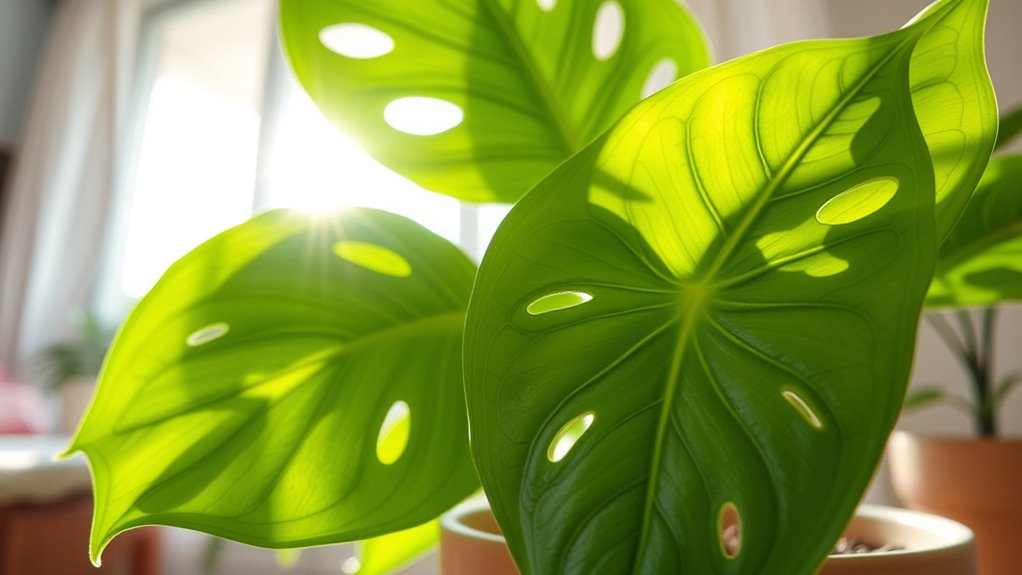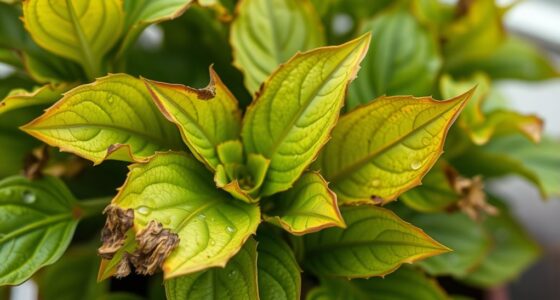To care for your Monstera, keep the soil moist but not soggy by watering when the top inch feels dry, usually once a week in spring and summer. Provide bright, indirect light and guarantee good drainage to prevent root rot. Watch for signs of over- or underwatering, pests, and leaf browning. Regular inspections, proper watering, and maintaining a healthy environment will keep your plant thriving. Stick around to discover how to master these care tips and grow a stunning Monstera.
Key Takeaways
- Water thoroughly when the top inch of soil feels dry, adjusting frequency seasonally to prevent over or underwatering.
- Ensure bright, indirect light and maintain consistent moisture for vibrant, healthy leaves.
- Regularly inspect for pests like spider mites and mealybugs; isolate and treat affected areas promptly.
- Use well-draining soil and drainage holes to prevent root rot from overwatering.
- Fertilize monthly during the growing season with a balanced, diluted houseplant fertilizer for optimal growth.

Monstera plants are popular for their striking leaves and tropical charm, but they require proper care to thrive. One of the most important aspects of caring for your Monstera is establishing a consistent watering schedule. These plants prefer their soil to stay moist but not soggy. You should water thoroughly when the top inch of soil feels dry to the touch. During the growing season, typically spring and summer, you might need to water once a week. In cooler months, reduce watering frequency to prevent overwatering, which can lead to root rot. Using well-draining soil and a pot with drainage holes helps manage excess water, protecting your plant’s roots. Keep an eye on your Monstera’s leaves; if they start to droop or develop brown tips, it might be a sign you’re either overwatering or underwatering. Adjust your watering schedule accordingly to maintain healthy growth.
Pest prevention is another critical element in keeping your Monstera healthy. While these plants are generally resilient, they can occasionally fall prey to common pests like spider mites, mealybugs, or scale insects. To prevent infestations, regularly inspect your plant’s leaves and stems, especially the undersides where pests often hide. Maintaining proper humidity levels and good air circulation can deter pests from settling in. Avoid overwatering, as overly damp conditions attract pests and foster fungal issues. If you notice tiny webs, sticky residues, or discolored spots, act quickly by isolating the plant and wiping affected areas with a gentle insecticidal soap or neem oil. Keeping your plant clean and healthy makes it less attractive to pests and easier to manage if problems arise.
Additionally, providing your Monstera with the right environment supports pest prevention and overall health. Bright, indirect light encourages strong, vibrant leaves, and consistent watering prevents stress that can weaken the plant’s defenses. Fertilize during the growing season with a balanced, diluted houseplant fertilizer to promote vigorous growth. Remember, healthy plants are less vulnerable to pests and diseases. Proper remote work setup can also contribute to your ability to monitor and care for your plant regularly, ensuring it remains healthy and thriving. By paying close attention to your watering schedule and proactively preventing pests, you’ll ensure your Monstera remains a lush, eye-catching centerpiece. With a little effort and observation, you’ll enjoy the tropical beauty of your Swiss Cheese Plant for years to come.
Frequently Asked Questions
How Often Should I Repot My Monstera?
You should repot your monstera every 1 to 2 years, depending on its growth stages. When the plant outgrows its current pot, roots become crowded and may start to circle the pot’s edge. Look for signs like slowed growth or roots poking out of drainage holes. Regular repotting encourages healthy growth, prevents root bound issues, and keeps your plant thriving. Keep an eye on its size and root health to decide the best time.
What Are Common Pests That Affect Swiss Cheese Plants?
You’ll want to watch for common pests like spider mites, mealybugs, and scale insects that can harm your Swiss cheese plant. To prevent pests, practice regular pest prevention methods and inspect your plant often. If you notice pests, try natural remedies such as neem oil or insecticidal soap to treat infestations. Consistent care helps keep your plant healthy and pest-free, ensuring it stays vibrant and thriving.
Can Monstera Thrive Outdoors Year-Round?
Did you know that only about 10% of Monsteras thrive outdoors year-round? You should consider their climate adaptability and outdoor safety. If you live in a warm, humid zone, your Monstera might do well outside, but in colder or fluctuating climates, it’s risky. To keep your plant healthy, monitor weather patterns, bring it inside when temperatures drop, and make sure it’s protected from cold drafts or direct harsh sunlight.
How Do I Propagate Monstera From Stem Cuttings?
To propagate your monstera from stem cuttings, start by selecting healthy, mature stems with at least one leaf and aerial root if possible. Use clean, sharp scissors to make a clean cut just below a node. Follow stem cutting tips like removing lower leaves and placing the cutting in water or moist soil. With proper care, these tips will boost your propagation success, helping you grow a lush new Monstera.
What Signs Indicate My Monstera Needs More Light?
Did you know that over 60% of indoor plants suffer from light deficiency? If your monstera’s leaves turn yellow or develop brown patches, it’s a clear sign it needs more light. You might also notice slower growth or smaller leaves. To help your plant thrive, move it closer to a bright, indirect light source. Ensuring adequate light prevents leaf discoloration and keeps your monstera healthy and vibrant.
Conclusion
With a little attention and love, your monstera will thrive, transforming your space into a lush, green sanctuary. Remember, caring for your Swiss cheese plant is like tending a living masterpiece—each leaf a brushstroke of nature’s artistry. Embrace patience and consistency, and watch your monstera flourish, filling your home with vibrant life. After all, isn’t the joy of nurturing something so beautiful worth the effort? Your green thumb is just waiting to bloom.









